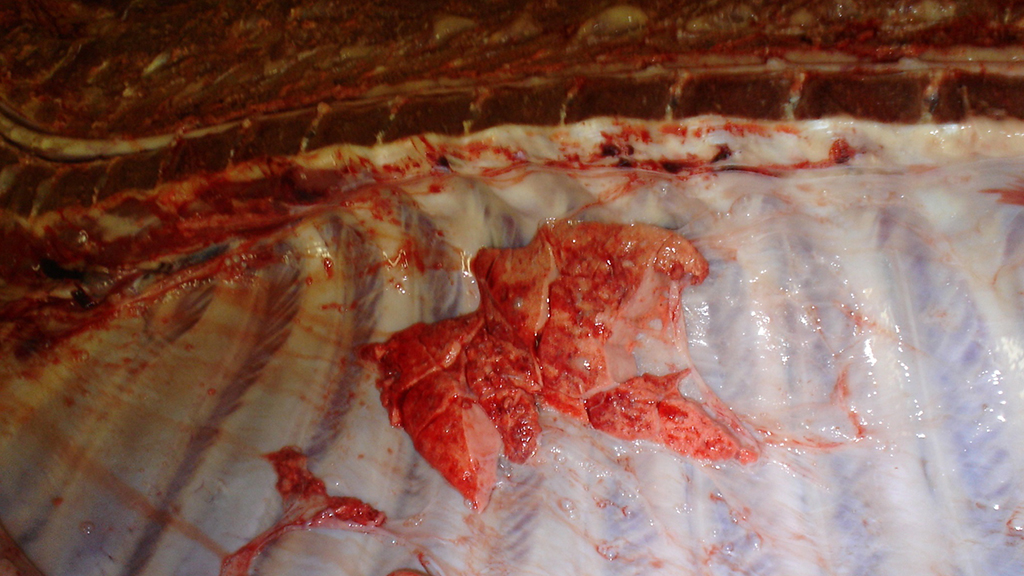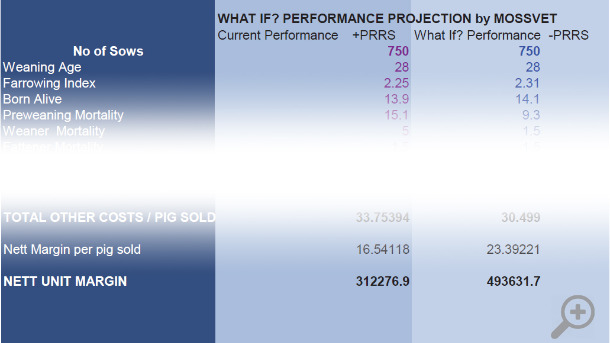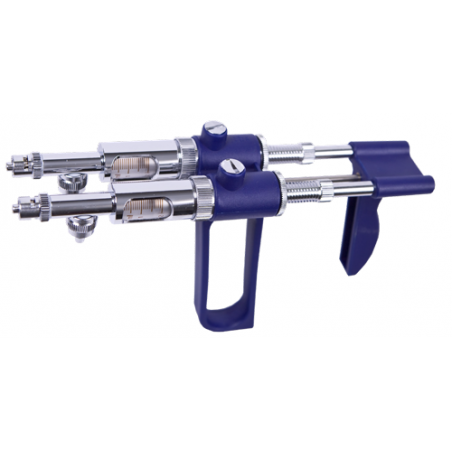PRRS infection was first diagnosed in Northern Ireland in 1997 (Anonymous 1997) and in the Republic of Ireland in 1999 (Ohlinger and others 2000). PRRS was enlisted as a Notifiable Disease in Northern Ireland (The Diseases of Animals -Northern Ireland- Order 1981) and in the Republic of Ireland (The Diseases of Animals Act –Republic of Ireland- 1966). The last surveillance carried out in Northern Ireland was in 2013. The percentage of producers that tested positive to PRRS was 43.49% (Borobia and Cottney 2015). The prevalence of PRRS in the Republic of Ireland has not been precisely assessed.
PRRS has an important economic impact in a pig unit. Our veterinary practice developed an estimated cost calculator of PRRS infection to our clients. It compares the current performance of a unit being positive to PRRS with the performance if the same unit was negative to PRRS. The economic potential lost in a unit positive to PRRS could be around 35 – 37% of net unit margin, as seen in Table 1. For this reason, elimination of PRRS from individual herds or regions should be considered.

Table 1. Estimated cost calculator of PRRS infection, an example. Click to enlarge
Severity of PRRS infection in pig units in Northern Ireland varies from unit to unit. Non-infectious factors such as management, pig flow, housing and temperature regulation exacerbate the expression of clinical signs (Zimmerman and others 2012). Concurrent infections with other viral and bacterial agents potentiate or add to the severity of clinical signs (Shibata and others 2003, Thacker and others 1999, van Reeth and others 1996). Pleurisy is one complication associated with PRRS infected animals (Muirhead and Alexander 1997a). BPEX (2009) found the economic impact of pleurisy was substantial. An increase in pleurisy incidence was associated with reduced carcase weight and increased weight age at slaughter. Cost to the producer, for a typical 10% pleurisy prevalence at batch level were shown to be in order of £2.26 per pig –based on reduced carcase weight and increased age at slaughter.
Pigs from 142 pig producers of Northern Ireland were examined in the slaughterhouse in May and June 2011. This sampling represented 95% of the pig population in Northern Ireland in 2011 (DARD 2013). The remaining producers were pet pigs or small holdings with less than 20 pigs. The lungs from these pigs were scored for pneumonia consolidation using the Muirhead 55 point scoring system (Muirhead and Alexander 1997). Furthermore, lesions of pleurisy, pericarditis, parasitic migration in the liver caused by Ascaris suum (Milk Spot), papular dermatitis and tail biting were recorded from these pigs. Finally, eight blood samples were collected at the sticking point of the slaughterhouse from each producer and analysed for PRRS seroconversion (ELISA).
Statistical analysis was carried out by using associations between pleurisy and each of the variables. Table 2 shows the results of the producers positive to PRRS (ELISA) and its relation with other post-mortem lesions with the corresponding confidence intervals.
Table 2. Prevalence of PRRS and pleurisy in Northern Ireland and incidence of several post-mortem lesions for PRRS positive herds. (CI: Confidence interval)
| Sample size | Number of cases | Percentage | CI 95 % | |
| Overall PRRS prevalence | 142 | 52 | 36.62 | 28.70 – 44.54 |
| Prevalence of pleurisy | 142 | 130 | 91.55 | 86.97 – 96.12 |
| Prevalence of pleurisy (≥10%) | 142 | 71 | 50.00 | 1.01 – 9.13 |
| PRRS & Pleurisy (+) | 52 | 45 | 86.54 | 77.26 – 95.82 |
| PRRS & Pleurisy ≥ 10% (+) | 52 | 22 | 42.31 | 22.88 – 55.74 |
| PRRS & Enzootic Pneumonia (+) | 52 | 47 | 90.38 | 82-37 – 98.40 |
| PRRS & Average Enzootic Pneumonia ≥ 2.0 | 52 | 11 | 21.15 | 1.51 – 10.38 |
| PRRS & APP (+) | 52 | 6 | 11.54 | 0.22 – 6.47 |
| PRRS & Pericarditis (+) | 52 | 34 | 65.38 | 0.02 – 5.01 |
There is a significant association between PRRS positive and pleurisy using the Fisher’s Exact Test. PRRS may be a risk factor for pleurisy using a binary logistic regression. If the herd is PRRS positive, then it is 2.34 times (odds ratio) more likely to be pleurisy positive than if the herd is PRRS negative. However, there was no significant difference in the distributions and severity of pleurisy in the lungs between PRRS positive or negative pigs. Furthermore, there was no significant difference between enzootic pneumonia, pericarditis, abscesses in lungs and necrotising pneumonia lesions between PRRS positive or negative pigs.
Figure 1. Pleurisy in lungs.

The results of this study indicated that there is an association between PRRS infection and pleurisy (Figure 1), as in the study carried by BPEX (2009). However, contrary to Zimmerman and others (2012), there was no association between PRRS infection and bacterial bronchopneumonia. This could be due to the low prevalence on Enzootic Pneumonia-like lesions as a result of intense vaccination programs over many years.








